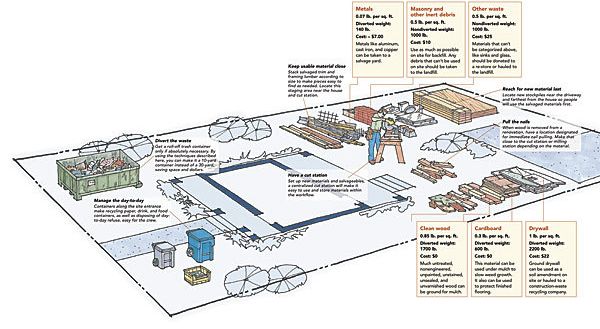The Remodeler’s Guide to Construction Debris
A thoughtful plan is the key to minimizing waste and maximizing profit.

Synopsis: Creating a thorough waste-management plan has the potential to reap financial and environmental rewards. Code officials are seeing the potential impact as well, and in some areas of the country, such as Boulder, Colo., and San Mateo, Calif., a plan is required by law. Using thoughtful, systematic strategies to divert materials from the landfill is the simplest way to reduce tipping fees. Author Rob Moody, a building-science consultant and educator, looks at all aspects of a typical building site, including the layout of materials, and outlines ways to minimize waste, whether it’s separating “dirty” wood from “clean” wood, exploring all recycling options, or using masonry and other inert debris as backfill on site.
Before I became a building-science consultant and teacher, I spent seven years as a self-labeled green builder. Before that, I was an ecology teacher, and for that reason, the amount of waste generated on my building and remodeling sites always seemed extreme to me. As a builder, I developed better ways to manage the material we handled in an effort to create as little waste as possible. Although the learning curve was steep, my approach reduced our waste stream by 40% to 60%.
In retrospect, however, I can see that my methods were elementary. As a teacher and consultant for the past four years, I’ve had the opportunity to work with many other builders and officials around the country, and I’ve learned that creating a thorough waste-management plan has the potential to reap even better financial and environmental rewards than the system I’d used. As it turns out, code officials are seeing the potential impact as well: In some areas of the country, such as Boulder, Colo., and San Mateo, Calif., a plan is required by law.
Avoid the landfill to save money
Even if your municipality doesn’t require a waste-management plan, you can still benefit from one. Using thoughtful, systematic strategies to divert materials from the landfill is the simplest way to reduce tipping fees and to protect your bottom line.
For example, tipping fees can be significantly lower for items like “clean” wood. Clean wood lacks glue, paint, stain, varnish, and chemical treatment. Our local county landfill takes clean wood at $20 per ton compared to almost $43 per ton for mixed construction and demolition waste. You might be able to find a local stump dump — a place that produces mulch and wood chips — that will accept clean lumber scrap for even less.
What I didn’t know early on is that there’s actually a market for certain waste materials. Separating valuable materials like metal (from 2¢ to 10¢ per lb., depending on the market) can actually help to recoup some Dumpster tipping fees while minimizing how much is going into the landfill.
Different companies charge for waste differently. Some have time-based rental fees for Dumpsters, while others charge per ton or per cubic yard, including the Dumpster delivery and pickup. When you consider taking pickup-truck loads to the transfer station, make sure you take into account not only the tipping fee, but also the distance traveled to the landfill.
Just as with bulk disposal to the landfill, you’ll have to account for fuel charges, vehicle maintenance, and a driver’s time. Often, recycling facilities are closer to city centers for convenience, and that may or may not be convenient to a job site. Additionally, many landfill transfer stations won’t accept construction and demolition debris.
For more photos, illustrations, and details, click the View PDF button below:
Fine Homebuilding Recommended Products
Fine Homebuilding receives a commission for items purchased through links on this site, including Amazon Associates and other affiliate advertising programs.

Handy Heat Gun

Affordable IR Camera

8067 All-Weather Flashing Tape






















